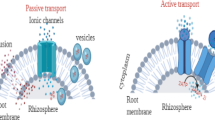Abstract
Several Alnus species are commonly found growing along rivers and lakes. Alnus forms root nodules with N2-fixing Frankia. We used plant bioassays to detect presence of infective Frankia in river and lake sediments from northern Sweden and Alaska. Silty river water and superficial river and lake sediments from all sites contained infective and effective Frankia, but 100-3000 year old lake sediments did not produce nodulated plants. Action by streams, waves and changing water levels transport Frankia in superficial sediments and can provide an inoculum for Alnus roots.
Similar content being viewed by others
References
Arveby A S and Huss-Danell K 1988 Presence and dispersal of infective Frankia in peat and meadow soils in Sweden. Biol. Fert. Soils 6, 39–44.
Baker D D 1987 Relationships among pure cultured strains of Frankia based on host specificity. Physiol. Plant. 70, 245–248.
Bond G 1976 The results of the IBP survey of root-nodule formation in non-leguminous angiosperms. In Symbiotic Nitrogen Fixation in Plants. Ed. P S Nutman. pp 443–474. Cambridge Univ. Press, Cambridge.
Burleigh S and Torrey J G 1990 Effectiveness of different Frankia cell types as inocula for the actinorhizal plant Casuarina. Appl. Environ. Microbiol. 56, 2565–2567.
Du D and Baker DD 1992 Actinorhizal host-specificity of chinese Frankia strains. Plant Soil 144, 113–116.
Huss-Danell K 1991 Influence of host (Alnus and Myrica) genotype on infectivity, N2 fixation, spore formation and hydrogenase activity in Frankia. New Phytol. 119, 121–127.
Huss-Danell K 1997 Actinorhizal symbioses and their N2 fixation. Tansley Review No. 93. New Phytol. 136, 375–405.
Huss-Danell K and Myrold D D 1994 Intrageneric variation in nodulation of Alnus: Consequences for quantifying Frankia nodulation units in soil. Soil Biol. Biochem. 26, 525–531.
Lumini E and Bosco M 1996 PCR-restriction fragment length polymorphism identification and host range of single-spore isolates of the flexible Frankia sp. strain UFI 132715. Appl. Environ. Microbiol. 62, 3026–3029.
Moore P D, Webb J A and Collinson M E 1991 Pollen Analysis. Blackwell, Oxford. 216 pp.
Myrold D D and Huss-Danell K 1994 Population dynamics of Alnus infective Frankia in a forest soil with and without host trees. Soil Biol. Biochem. 26, 533–540.
Nilsson M and Renberg I 1990 Viable endospores of Thermoactinomyces vulgaris in lake sediments as indicators of agricultural history. Appl. Environ. Microbiol. 56, 2025–2028.
Renberg I 1981a Improved methods for sampling, photographing and varve-counting of varved lake sediments. Boreas 10, 255– 258.
Renberg I 1981b Formation, structure and visual appearance of iron-rich, varved lake sediments. Verh. Internat. Verein. Limnol. 21, 94–101.
Renberg I 1991c The HON-Kajak sediment corer. J. Paleolimnol. 6, 167–170.
Segerström U 1990 The natural holocene vegetation development and the introduction of agriculture in northern Norrland, Sweden. Studies of soil, peat and especially varved lake sediments. PhD Thesis, Dept. of Ecological Botany, University of Umeå, Sweden.
Tzean S S and Torrey J G 1989 Spore germination and the life cycle of Frankia in vitro. Can. J. Microbiol. 35, 801–806.
Viereck L A, Dyrness C T and Foote M J 1993a An overview of the vegetation and soils of the floodplain ecosystems of the Tanana River, interior Alaska. Can. J. For. Res. 23, 889–898.
Viereck L A, Van Cleve K, Adams P C and Schlentner R E 1993b Climate of the Tanana River floodplain near Fairbanks, Alaska. Can. J. For. Res. 23, 899–913.
Author information
Authors and Affiliations
Rights and permissions
About this article
Cite this article
Huss-Danell, K., Uliassi, D. & Renberg, I. River and lake sediments as sources of infective Frankia (Alnus). Plant and Soil 197, 35–39 (1997). https://doi.org/10.1023/A:1004268931699
Issue Date:
DOI: https://doi.org/10.1023/A:1004268931699




